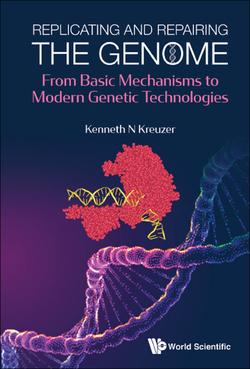Читать книгу Replicating And Repairing The Genome: From Basic Mechanisms To Modern Genetic Technologies - Kenneth N Kreuzer - Страница 22
На сайте Литреса книга снята с продажи.
2.6Structural model for the T7 replisome
ОглавлениеA recent culmination of structural approaches provides a dramatic and informative three-dimensional model for the T7 replisome. One key study determined the structure of a complex of the helicase/primase with T7 DNA polymerase in the absence of DNA, using X-ray crystallography and other methods (Figure 2.6A). The helicase/primase was in a heptameric form, consistent with the DNA-free form discussed above. Somewhat surprisingly, the complex contained not two but three copies of the DNA polymerase! The authors speculated that the third DNA polymerase might serve as a spare, available to exchange with one of the actively synthesizing polymerases if the latter became blocked or disabled.
More recently, a method called cryo-electron microscopy (cryo-EM) was used to determine the structure of the T7 replisome complexed with DNA that mimics a replication fork (Figure 2.6B and cartoon in Figure 2.6C). In this case, the helicase/primase was in a hexameric form, as expected when bound to ssDNA (see above). As in the previous study using X-ray crystallography, three DNA polymerases were bound to the helicase/primase complex. In the cryo-EM study, the two active polymerases (leading and lagging strand) could be identified, and the third polymerase did appear as a spare, showing no engagement with a DNA primer/template.4
This stunning model of an active replication complex has several notable features that illuminate the replication process. Starting at the parental DNA, the separation point of the parental duplex is actually within the leading-strand polymerase, not the helicase! This came as a surprise to those who expected that the unwinding enzyme would be at the frontline of an unwinding reaction. However, recall that unwinding by the helicase is greatly accelerated when it is in complex with polymerase, and the two proteins clearly work in concert with one another (see above).
Figure 2.6.Current models for the structure of the T7 replisome. Two orientations of an X-ray crystal structure of the T7 replisome in the absence of DNA are shown in panel A. The central core is a heptameric helicase (varied colors) with three associated DNA polymerase/thioredoxin complexes (labeled Pol and Trx, respectively). Recall that the T7 helicase forms a heptamer rather than a hexamer in the absence of DNA. The image on the right provides a rotated view showing the underside with three of the primase domains (labeled Pri) extruding from the core. The structures are from the RCSB PDB (www.rcsb.org) of PDB ID 5IKN (Wallen et al., 2017). The replisome structure in panel B, containing replication fork DNA, was derived from a combination of structural methods. The hexameric form of the helicase is complexed with three DNA polymerases, one engaged with leading strand, one with lagging strand, and one “apo” form that is not engaged with DNA. The leading-strand polymerase and helicase collaborate in unwinding the parental DNA, and the template strand for laggingstrand synthesis threads through the helicase before engaging DNA polymerase. This image is reproduced from Gao et al. (2019), with permission from the American Association for the Advancement of Science; permission conveyed by Copyright Clearance Center, Inc. Panel C provides a cartoon tracing how the replisome structure in panel B relates to the trombone model of Figure 2.5 and the helicase movement pathway in Figure 2.4B.
The leading-strand template DNA, just past the unwinding point, enters the active site of the leading-strand polymerase (top DNA polymerase in Figure 2.6B). This leaves only a few nucleotides of ssDNA between the unwinding point and the point of leading-strand extension on that template strand.
In contrast, the lagging-strand template DNA bends away from the leading-strand polymerase, threads through the helicase/primase complex (12 nucleotides of DNA; see above), and emerges in the vicinity of the lagging-strand polymerase (bottom left polymerase in Figure 2.6B). As it exits the helicase/primase, the DNA traverses a protein-free region before entering the lagging-strand DNA polymerase, presumably allowing the formation and loss of the lagging-strand loops during active DNA replication.
Each of the three bound DNA polymerases contacts two primase domains in this replisome structure. Recall that an alternative form of helicase/primase lacking a portion of the primase domain is also produced in vivo. Future studies will undoubtedly investigate whether a very similar replisome structure forms with three copies of full-length helicase/primase, three copies of truncated helicase/primase, and three copies of DNA polymerase.
Considering the positions of the leading- and lagging-strand polymerases, the third (unengaged) DNA polymerase (bottom right in Figure 2.6B) is in prime position to take over synthesis on the lagging strand should the lagging-strand polymerase become disabled or dissociate. It will be interesting to deduce the structural transitions that occur during this proposed polymerase-switching process.
With these remarkable advances in the T7 replication system, we are now in a position where we can contemplate how the trombone model plays out in the context of an actual three-dimensional structure of a protein complex of some 600,000 Daltons. Using the structural model (Figure 2.6B) and cartoon (Figure 2.6C) as guides, try to visualize how the parental, leading, and lagging strands slide through the complex during the various steps of DNA replication.5
